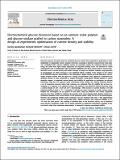| dc.contributor.author | Jayakumar, Kavita | |
| dc.contributor.author | Bennett, Richard | |
| dc.contributor.author | Leech, Dónal | |
| dc.date.accessioned | 2021-05-05T09:28:08Z | |
| dc.date.available | 2021-05-05T09:28:08Z | |
| dc.date.issued | 2021-01-25 | |
| dc.identifier.citation | Jayakumar, Kavita, Bennett, Richard, & Leech, Dónal. (2021). Electrochemical glucose biosensor based on an osmium redox polymer and glucose oxidase grafted to carbon nanotubes: A design-of-experiments optimisation of current density and stability. Electrochimica Acta, 371, doi:https://doi.org/10.1016/j.electacta.2021.137845 | en_IE |
| dc.identifier.issn | 0013-4686 | |
| dc.identifier.uri | http://hdl.handle.net/10379/16741 | |
| dc.description.abstract | Enzymatic glucose electrodes based on mediated electron transfer have potential for application as semi-implantable or implantable sensors. Enzyme electrodes consisting of adsorbed osmium-based redox polymer crosslinked with a glucose oxidising enzyme are promising systems for continuous glucose monitoring, but suffer from signal output magnitude and long-term stability issues. The inclusion of carbon nanosupports such as multiwalled carbon nanotubes (MWCNTs) into these sensors tends to increase characteristics such as current density and surface coverage of enzyme or mediator. However, large quantities of nanomaterials are often necessary to see significant effects. Grafting of the enzyme to the surface of the MWCNTs improves dispersibility of the nanosupport aiding enzyme electrode fabrication, and increases enzyme activity. Here we report on a design of experiments (DoE) approach to determine the optimum amount of each component in enzyme electrodes, using glucose oxidase grafted to carbon nanotube support, to maximise current density and stability for application to continuous use glucose biosensing. Using the DoE approach while considering current density and stability responses delivers a set of component amounts where both responses are optimised. Thus far stability has not been investigated as a response to be optimised using a DoE approach. The optimised enzyme electrodes show a current density of 3.18 ± 0.30 mA cm−2, representing a 146% increase in current density in 50 mM phosphate-buffered saline at 37 °C containing 5 mM glucose when compared to similar systems where enzyme and nanosupport are not grafted to each other. Using the predictive DoE model, component amounts were then modified to minimise the quantity of the nanoconjugate while showing similar electrochemical behaviour and current density to the optimised system, using 93% less of the nanoconjugate. However, the operational stability under continuous use was moderate with only ≈ 50% amperometric current retained after 12 hr use. Overcoating with a Nafion protective layer improved stability to 72–75% over the same period. The coupling of adsorbed films to the electrode surface, use of additional perm-selective membranes, and/or use of pulsed potentials to implement intermittent sampling of glucose levels, rather than continuous amperometry, is proposed to improve operational stability. | en_IE |
| dc.description.sponsorship | This Publication is part of a project that has received funding from the European Union's Horizon 2020 research and innovation programme under grant agreement Nº813006. RB acknowledges funding from the Irish Research Council (GOIPG/2016/505). | en_IE |
| dc.format | application/pdf | en_IE |
| dc.language.iso | en | en_IE |
| dc.publisher | Elsevier | en_IE |
| dc.relation.ispartof | Electrochimica Acta | en |
| dc.rights | Attribution-NonCommercial-NoDerivs 3.0 Ireland | |
| dc.rights.uri | https://creativecommons.org/licenses/by-nc-nd/3.0/ie/ | |
| dc.subject | Glucose biosensor | en_IE |
| dc.subject | Mediation | en_IE |
| dc.subject | Enzyme electrode | en_IE |
| dc.subject | Design-of-experiment | en_IE |
| dc.title | Electrochemical glucose biosensor based on an osmium redox polymer and glucose oxidase grafted to carbon nanotubes: A design-of-experiments optimisation of current density and stability | en_IE |
| dc.type | Article | en_IE |
| dc.date.updated | 2021-05-04T15:50:19Z | |
| dc.identifier.doi | 10.1016/j.electacta.2021.137845 | |
| dc.local.publishedsource | https://doi.org/10.1016/j.electacta.2021.137845 | en_IE |
| dc.description.peer-reviewed | peer-reviewed | |
| dc.contributor.funder | Horizon 2020 | en_IE |
| dc.contributor.funder | Irish Research Council | en_IE |
| dc.internal.rssid | 25892725 | |
| dc.local.contact | Donal Leech, Vp For Research, Nui Galway. 5349 Email: donal.leech@nuigalway.ie | |
| dc.local.copyrightchecked | Yes | |
| dc.local.version | PUBLISHED | |
| dcterms.project | info:eu-repo/grantAgreement/EC/H2020::MSCA-ITN-ETN/813006/EU/Mass-transfer independent long-term implantable biosensors/ImplantSens | en_IE |
| nui.item.downloads | 86 | |


